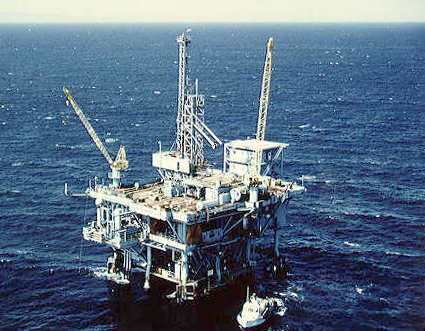Above: photo credit Bureau of Ocean Energy Management
One of the more unusual recent developments in ocean conservation has been the use of artificial reefs. Old ships and even old subway cars have been used to create environments for fish to congregate in areas of the seafloor that are otherwise featureless. But it’s not clear whether these habitats provide a place for fish to gather or actually boost the fish populations in the area.
A new study looked at the productivity of a different sort of artificial reef: the oil and natural gas rigs that dot the state’s coastline. The report finds that the oil rigs are the most productive fisheries ever measured—not only in California but in the entire world. The report notes that many of these platforms will be obsolete over the coming decades, and we might want to think about what we do when we’re done using them for their original purpose.
There are different ways of measuring an ecosystem’s productivity. One is primary productivity, or how much carbon dioxide is converted into useful organic molecules by plants and other photosynthetic organisms. Then there’s secondary productivity, defined as how much of that finds its way to herbivores and predators. In this case, the authors were interested in fish, so they focused on secondary productivity.
To measure the productivity, they relied on an annual survey performed with a remotely operated vehicle. Different sites were visited for at least five years, some as many as 15, with fish abundance and species assessed visually. Total biomass was also estimated from this data, and the change in biomass between years was then normalized to the area of seafloor covered by the survey.
The numbers were staggering. The most productive places in the scientific literature (a reef in Tahiti and an estuary in Louisiana) saw annual productivity of about 75 grams for each square meter. The lowest of the oil rigs came in at 105 grams per square meter per year, and the highest as nearly 900. The authors were even being conservative by not including any fish more than a couple of meters from the structure, which ignores the entire water column enclosed by the rig’s legs.
The most obvious reason for this productivity is the fact that, unlike most reefs, an oil rig extends from the surface to the significant depths., allowing it to attract fish that prefer habitats at a wide variety of depths. The authors tried to compensate by only counting things near the ocean floor, but even then, the oil rigs were more productive than natural habitats, though not by such an extreme margin.
The vertical structure may actually contribute directly to the appeal of the oil rigs for many species of rockfish. As these fish age, they tend to move to greater depths. In the case of many of these oil rigs, they can do so without ever leaving the habitat. Combined with lower levels of predators than what was observed at natural reefs in the same area, this makes the environment around the rig a very appealing one for many species of fish.
Does this represent a case of higher productivity at the rigs themselves or a greater recruitment of fish at different stages of their lives to the sites? The authors can’t truly know, but they do point to other studies showing that in some species of fish, individuals simply don’t survive if they can’t find their way to an appropriate habitat.
So oil rigs appear to be good for the fish, which poses both a problem and an opportunity. There are now over 7,500 oil and natural gas platforms in the oceans around the world, and all of them will eventually cease production. Normally, you’d expect that removing the equipment and recycling its materials might be the most environmentally friendly option. But if these results are found in other habitats, then it’s possible that leaving everything in place would be the best thing for the local ecosystem.
At the same time, the authors note, there are lots of new offshore wind facilities being constructed. If we can figure out the features that make these oil rigs so appealing to fish, it’s possible we could engineer these deployments so that they boost local marine life. It won’t stop people from complaining about the wind turbines spoiling their view, but those complaints might be drowned out by the appreciations of fishermen.
This article was re-posted from arstechnica.com – please click here for the original article.






